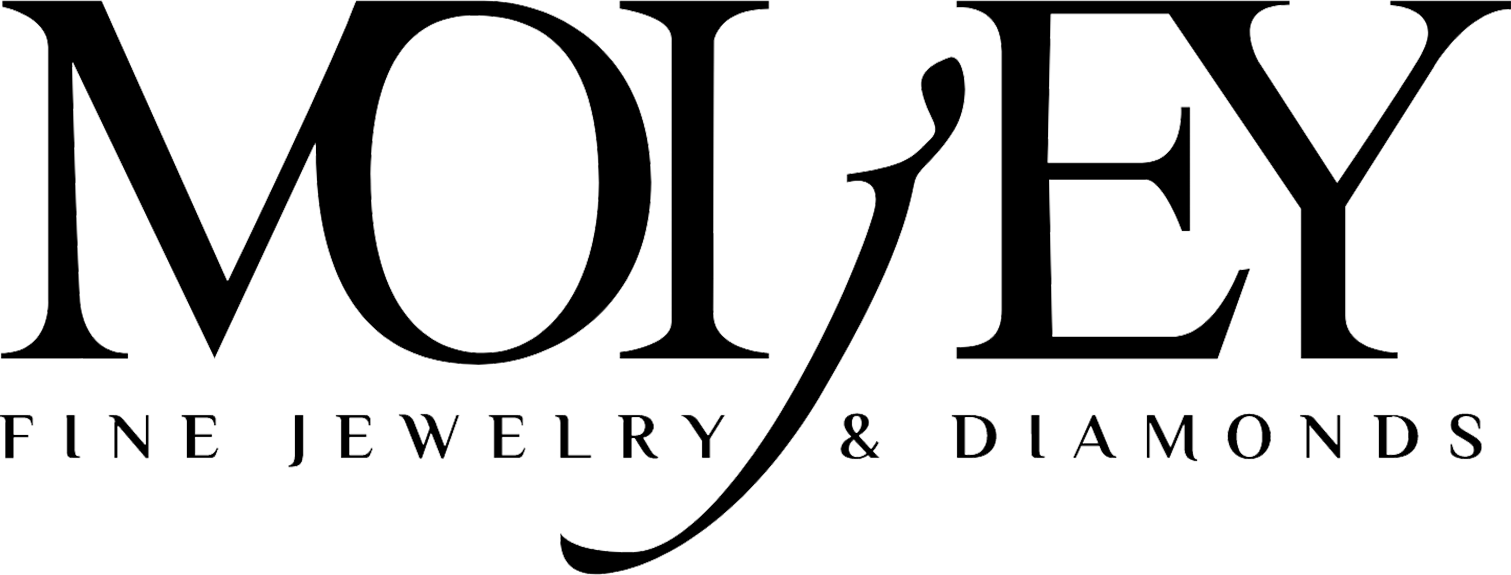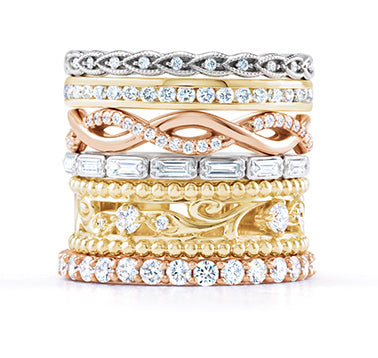Lifetime Warranty
24/7 Customer Service
Free Shipping
30-Day Return
Moijey Fine Jewelry & Diamonds Blog
A Rainbow of Diamonds
Originally posted on April 12th, 2017
Updated on April 2nd, 2020
Can you believe that a large pink diamond sold at auction for over $71 million? It's crazy!

This pink diamond aptly named the Pink Star is the most expensive gem sold in auction history. It outbid the Oppenheimer Blue, a stunning emerald-cut blue diamond that sold for over $57 million last year.
I'm just as surprised as you are. Not only for the quality of the diamonds but for the beautiful colors they possess. Colors you would see in a children's book.
Usually, in the gem and jewelry industry, the less color a diamond has, the more valuable it is. Subtle changes in the diamond's color saturation and hue can have a dramatic effect on its worth. When GIA created the 4Cs, they produced scales for grading diamond color from colorless to light yellow or brown. Here are the GIA Color Scale and a picture of different colored diamonds from colorless to light.


Since I started this article talking about pink and blue diamonds, our focus will be more on the more intense colors that belong to fancy colored diamonds, or fancies.
Do you know how the GIA Color Scale has letter grades for diamonds? Colored diamonds go by titles like Faint or Fancy, for example. Fancy Vivid is the color grade for the Pink Star. For reference, here is a guide to Blue Diamond Color Grading from GIA.

These gorgeous diamonds are rare in nature and acquire their colors from trace elements in their chemical composition. Recently, I said that diamonds are composed of carbon atoms. Sometimes, there's more than carbon when diamond crystals are forming 90 to 120 miles beneath our feet. For the Pink Star, chromium was present when the diamond d, producing the $71 million shade of pink.
Pink diamonds obtain their color from chromium, while blue diamonds acquire their regal hues from boron. The primary sources of blue diamonds are in South Africa, where miners discovered the Fancy Vivid Oppenheimer Blue.

Another cool thing about blue diamonds is that they can conduct electricity. Oddly enough, synthetic blue diamonds -blue diamonds produced in a lab and not in nature- don't conduct electricity.
I am also happy to say that Moijey has recently acquired blue diamond jewelry for our diamond room in Silver Spring, MD. We can now provide our customers with either our sparkling 14K White Gold Blue & White Diamond Halo Pendant or our sweet and subtle 14K White 1/6 CTW Blue Diamond Stackable Ring.


Blue and pink fancy colored diamonds are one of the rarest fancy colored diamonds in the world, while yellow and brown diamonds are the most common fancy colored diamonds. Both yellow and brown diamonds have nitrogen in their crystal structures.
Hold on! How can brown diamonds have nitrogen and not turn yellow?
Good question. The crystal structure of brown diamonds became twisted while forming 90 to 120 miles beneath our feet. Several brown diamonds are found in Australia and marketed with romantic names like champagne and cognac. Our 14K White Gold Pave Hoop Earrings provide sparkling brown diamonds reminiscent to equally sparkling champagne.

We also provide yellow diamond jewelry as well, like our 14kt 1/8 CTW Natural Yellow Diamond Anniversary Band, available in either yellow gold or white gold.

Are there more colors besides what the author mentioned?
YES!
Diamonds come in all kinds of colors! In every color of the rainbow. Throughout the world, there are red diamonds with more chromium in their chemical composition than pink diamonds. Orange diamonds exist, but they are so rare that scientists don't know how they get their orange color.
We already covered yellow and blue diamonds, and due to exposure to radioactive chemicals, green diamonds exist. Green diamonds usually have their color as a "skin" after exposed to radium compounds while forming in the earth. So the green diamond rough has to be strategically cut to retain the green color. If the cutter isn't careful, the green diamond will become colorless.

The Aurora Green, which sold at auction for $16.8 million in 2016, is an excellent green diamond example.
The color indigo is comparable to our new blue diamond jewelry I mentioned earlier in this article, and there are purple diamonds recently discovered in Siberia.
There is so much more to color for diamonds, and this is only the beginning. Come back to Moijey soon, and we will provide more articles about the glory and joys of diamonds.
A Rainbow of Diamonds
Originally posted on April 12th, 2017
Updated on April 2nd, 2020
Can you believe that a large pink diamond sold at auction for over $71 million? It's crazy!
This pink diamond aptly named the Pink Star is the most expensive gem sold in auction history. It outbid the Oppenheimer Blue, a stunning emerald-cut blue diamond that sold for over $57 million last year.
I'm just as surprised as you are. Not only for the quality of the diamonds but for the beautiful colors they possess. Colors you would see in a children's book.
Usually, in the gem and jewelry industry, the less color a diamond has, the more valuable it is. Subtle changes in the diamond's color saturation and hue can have a dramatic effect on its worth. When GIA created the 4Cs, they produced scales for grading diamond color from colorless to light yellow or brown. Here are the GIA Color Scale and a picture of different colored diamonds from colorless to light.


Since I started this article talking about pink and blue diamonds, our focus will be more on the more intense colors that belong to fancy colored diamonds, or fancies.
Do you know how the GIA Color Scale has letter grades for diamonds? Colored diamonds go by titles like Faint or Fancy, for example. Fancy Vivid is the color grade for the Pink Star. For reference, here is a guide to Blue Diamond Color Grading from GIA.

These gorgeous diamonds are rare in nature and acquire their colors from trace elements in their chemical composition. Recently, I said that diamonds are composed of carbon atoms. Sometimes, there's more than carbon when diamond crystals are forming 90 to 120 miles beneath our feet. For the Pink Star, chromium was present when the diamond d, producing the $71 million shade of pink.
Pink diamonds obtain their color from chromium, while blue diamonds acquire their regal hues from boron. The primary sources of blue diamonds are in South Africa, where miners discovered the Fancy Vivid Oppenheimer Blue.

Another cool thing about blue diamonds is that they can conduct electricity. Oddly enough, synthetic blue diamonds -blue diamonds produced in a lab and not in nature- don't conduct electricity.
I am also happy to say that Moijey has recently acquired blue diamond jewelry for our diamond room in Silver Spring, MD. We can now provide our customers with either our sparkling 14K White Gold Blue & White Diamond Halo Pendant or our sweet and subtle 14K White 1/6 CTW Blue Diamond Stackable Ring.


Blue and pink fancy colored diamonds are one of the rarest fancy colored diamonds in the world, while yellow and brown diamonds are the most common fancy colored diamonds. Both yellow and brown diamonds have nitrogen in their crystal structures.
Hold on! How can brown diamonds have nitrogen and not turn yellow?
Good question. The crystal structure of brown diamonds became twisted while forming 90 to 120 miles beneath our feet. Several brown diamonds are found in Australia and marketed with romantic names like champagne and cognac. Our 14K White Gold Pave Hoop Earrings provide sparkling brown diamonds reminiscent to equally sparkling champagne.

We also provide yellow diamond jewelry as well, like our 14kt 1/8 CTW Natural Yellow Diamond Anniversary Band, available in either yellow gold or white gold.

Are there more colors besides what the author mentioned?
YES!
Diamonds come in all kinds of colors! In every color of the rainbow. Throughout the world, there are red diamonds with more chromium in their chemical composition than pink diamonds. Orange diamonds exist, but they are so rare that scientists don't know how they get their orange color.
We already covered yellow and blue diamonds, and due to exposure to radioactive chemicals, green diamonds exist. Green diamonds usually have their color as a "skin" after exposed to radium compounds while forming in the earth. So the green diamond rough has to be strategically cut to retain the green color. If the cutter isn't careful, the green diamond will become colorless.

The Aurora Green, which sold at auction for $16.8 million in 2016, is an excellent green diamond example.
The color indigo is comparable to our new blue diamond jewelry I mentioned earlier in this article, and there are purple diamonds recently discovered in Siberia.
There is so much more to color for diamonds, and this is only the beginning. Come back to Moijey soon, and we will provide more articles about the glory and joys of diamonds.






